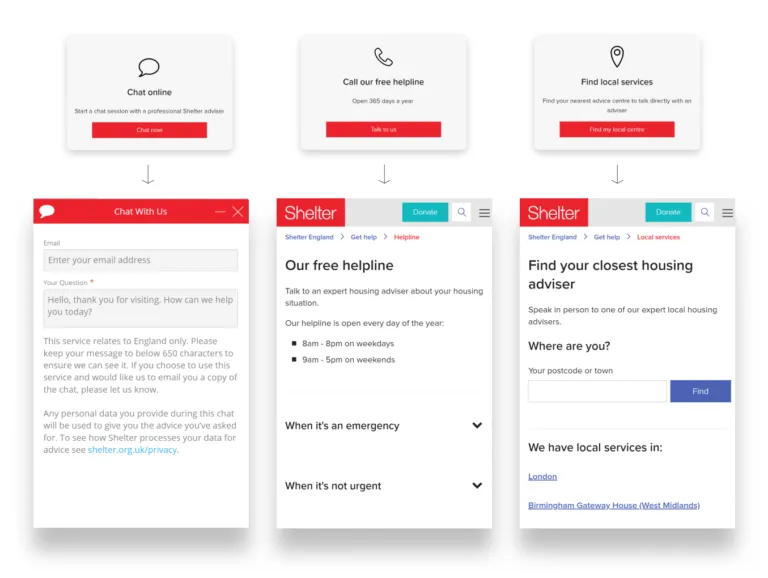Streamlining advice journeys
Published: by Matteo Remondini

Following a review of our services back in 2017, we began to think about why and how people access our help. We were keen to understand if there was anything we could do to improve the way our website users find the help they need.
We started by looking at the in-depth analysis produced by our researchers, and tried to pinpoint some trends. We also considered the expectations our website users would have for the kind of services we provide, and through user testing, confirmed the assumptions we made. This led to some fundamental questions which would help us better understand how and why people access our help:
- how do people find out about us?
- how do people prefer to access advice?
- why do people prefer to interact with an adviser, despite visiting our advice pages?
- do we know how many of our service users prefer to call our helpline, use web chat, or see someone face-to-face?
With information gathered from existing analytics and surveys we learnt that most of the people who call our helpline have visited Shelter’s website before.
What did we learn?
Most of our service users come to our website without knowing exactly what they’re looking for. While they know they have a problem and want help, they may not know what kind of help is available – or best-suited to their situation. For example, a person could be threatened with eviction because they can’t afford their rent after a recent rise.
They might come to our website for advice following an internet search, or recommendation from a friend. If the person is uncomfortable talking about their problem on the phone, they might search for a way to chat to one of our advisers online. Getting advice through our web chat service was only possible if a pop-up appeared on one of the pages in the advice section of our website. This made it difficult for users to find this service – even though it was an option.
Creating one point of contact
We proposed that a new ‘Get help’ page could act as one clear, unified entry point for people trying to access any of our services.

This would make it possible for us to:
- create a clear path for any advice journey, with the ability to introduce and test different advice options and evaluate their impact
- allow users to make a choice based on their own preference on how to access help, and give clear alternatives to users if they are not able to access one of our services
- for example, encouraging users to call the helpline if they don’t have face-to-face services available in their local area
Improved user experience
Since we created and published the new ‘Get help’ page, it has become the second-most-visited page of our website – after our homepage. Almost 90% of all web chats are started through this page, with the remaining 10% prompted (via pop-up) by our expert housing advisers on specific pages.
And as we always ‘design for data’ – that is, learning from real-world behaviour by looking at how existing services are used – we think of ways to measure usage outcomes. We can now more accurately analyse the journeys people take on our website. We’ve also been monitoring the impact of our experimental emergency helpline (which we’ll cover in an upcoming blog).
We’ve received positive feedback from both service users and Shelter staff members. One user said: ‘There were lots of ways to talk to people directly; live chat, phone numbers, and walk-in centres across the country… So, lots of options.’
And our Social Media Manager, Spike, told us about the impact it’s had in managing our social media communities:
‘The benefits are huge. Now we can direct people to this page in one comment or tweet, rather than sending a series explaining how they can access each service. Early results are positive, and it’s a clean, modern way to filter advice questions.’
What’s next?
After the success of our ‘Get help’ page, we’ve made our web chat function available to mobile device users too – meaning we can help more people – and the number of web chat advisers has doubled! We’ll keep working to improve this page, matching the changing needs of our service users.
Keep your eyes peeled for the upcoming blog, on the second iteration of our ‘Get help’ page… Coming soon!